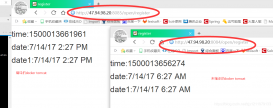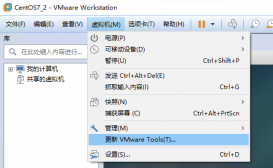前言
用户可以通过docker run的--volume/-v或--mount选项来创建带有数据卷的容器,但这两个选项有些微妙的差异,在这里总结梳理一下。
命令用法
--volume(-v)
参数--volume(或简写为-v)只能创建bind mount。示例:
|
1
2
3
4
|
docker run --name $CONTAINER_NAME -it \-v $PWD/$CONTAINER_NAME/app:/app:rw \-v $PWD/$CONTAINER_NAME/data:/data:ro \avocado-cloud:latest /bin/bash |
注释:
- 命令格式:[[HOST-DIR:]CONTAINER-DIR[:OPTIONS]]]
- 如果指定HOST-DIR则必须是绝对路径,如果路径不存在则会自动创建
- 实例中的rw为读写,ro为只读
--mount
参数--mount默认情况下用来挂载volume,但也可以用来创建bind mount和tmpfs。如果不指定type选项,则默认为挂载volume,volume是一种更为灵活的数据管理方式,volume可以通过docker volume命令集被管理。示例:
|
1
2
3
4
|
docker run --name $CONTAINER_NAME -it \--mount type=bind,source=$PWD/$CONTAINER_NAME/app,destination=/app \--mount source=${CONTAINER_NAME}-data,destination=/data,readonly \avocado-cloud:latest /bin/bash |
注释:
- 挂载volume命令格式:[type=volume,]source=my-volume,destination=/path/in/container[,...]
- 创建bind mount命令格式:type=bind,source=/path/on/host,destination=/path/in/container[,...]
- 如果创建bind mount并指定source则必须是绝对路径,且路径必须已经存在
- 示例中readonly表示只读
差异总结
创建bind mount和挂载volume的比较
| 对比项 | bind mount | volume |
|---|---|---|
| Source位置 | 用户指定 | /var/lib/docker/volumes/ |
| Source为空 | 覆盖dest为空 | 保留dest内容 |
| Source非空 | 覆盖dest内容 | 覆盖dest内容 |
| Source种类 | 文件或目录 | 只能是目录 |
| 可移植性 | 一般(自行维护) | 强(docker托管) |
| 宿主直接访问 | 容易(仅需chown) | 受限(需登陆root用户)* |
*注释:Docker无法简单地通过sudo chown someuser: -R /var/lib/docker/volumes/somevolume来将volume的内容开放给主机上的普通用户访问,如果开放更多权限则有安全风险。而这点上Podman的设计就要理想得多,volume存放在$HOME/.local/share/containers/storage/volumes/路径下,即提供了便捷性,又保障了安全性。无需root权限即可运行容器,这正是Podman的优势之一,实际使用过程中的确受益良多。
创建bind mount时使用--volume和--mount的比较
| 对比项 |
--volume 或 -v |
--mount type=bind |
|---|---|---|
| 如果主机路径不存在 | 自动创建 | 命令报错 |
官方文档
|
1
2
3
4
5
6
7
8
9
10
11
12
13
14
15
16
17
18
19
20
21
22
23
24
25
26
27
28
29
30
31
32
33
34
35
36
37
38
39
40
41
42
43
44
45
46
47
48
49
50
51
52
53
54
55
56
57
58
59
60
61
62
63
64
65
66
67
68
69
70
71
72
73
74
75
76
77
78
79
80
81
82
83
84
85
86
87
88
89
90
91
92
93
94
95
96
97
98
99
100
101
102
103
104
105
106
107
108
109
110
111
112
113
114
115
116
117
118
119
120
121
122
123
124
125
126
127
128
129
130
131
132
133
134
135
136
137
138
139
140
141
142
143
144
145
146
147
148
149
150
151
152
153
154
155
156
157
158
159
160
161
162
163
164
165
166
167
168
169
170
171
172
173
174
175
176
177
178
179
|
DOCKER(1) JUNE 2014 DOCKER(1)NAME docker-run - Run a command in a new containerSYNOPSIS docker run [--mount[=[MOUNT]]] [-v|--volume[=[[HOST-DIR:]CONTAINER-DIR[:OPTIONS]]]] IMAGEOPTIONS --mount type=TYPE,TYPE-SPECIFIC-OPTION[,...] Attach a filesystem mount to the container Current supported mount TYPES are bind, volume, and tmpfs. e.g. type=bind,source=/path/on/host,destination=/path/in/container type=volume,source=my-volume,destination=/path/in/container,volume-label="color=red",volume-label="shape=round" type=tmpfs,tmpfs-size=512M,destination=/path/in/container Common Options: · src, source: mount source spec for bind and volume. Mandatory for bind. · dst, destination, target: mount destination spec. · ro, readonly: true or false (default). Note: setting readonly for a bind mount does not make its submounts read-only on the current Linux implementation. See also bind-nonrecursive. Options specific to bind: · bind-propagation: shared, slave, private, rshared, rslave, or rprivate(default). See also mount(2). · consistency: consistent(default), cached, or delegated. Currently, only effective for Docker for Mac. · bind-nonrecursive: true or false (default). If set to true, submounts are not recursively bind-mounted. This option is useful for readonly bind mount. Options specific to volume: · volume-driver: Name of the volume-driver plugin. · volume-label: Custom metadata. · volume-nocopy: true(default) or false. If set to false, the Engine copies existing files and directories under the mount-path into the volume, allowing the host to access them. · volume-opt: specific to a given volume driver. Options specific to tmpfs: · tmpfs-size: Size of the tmpfs mount in bytes. Unlimited by default in Linux. · tmpfs-mode: File mode of the tmpfs in octal. (e.g. 700 or 0700.) Defaults to 1777 in Linux. -v|--volume[=[[HOST-DIR:]CONTAINER-DIR[:OPTIONS]]] Create a bind mount. If you specify, -v /HOST-DIR:/CONTAINER-DIR, Docker bind mounts /HOST-DIR in the host to /CONTAINER-DIR in the Docker container. If 'HOST-DIR' is omitted, Docker automatically creates the new volume on the host. The OPTIONS are a comma delimited list and can be: · [rw|ro] · [z|Z] · [[r]shared|[r]slave|[r]private] · [delegated|cached|consistent] · [nocopy] The CONTAINER-DIR must be an absolute path such as /src/docs. The HOST-DIR can be an absolute path or a name value. A name value must start with an alphanumeric character, followed by a-z0-9, _ (underscore), . (period) or - (hyphen). An absolute path starts with a / (forward slash). If you supply a HOST-DIR that is an absolute path, Docker bind-mounts to the path you specify. If you supply a name, Docker creates a named volume by that name. For example, you can specify either /foo or foo for a HOST-DIR value. If you supply the /foo value, Docker creates a bind mount. If you supply the foo specification, Docker creates a named volume. You can specify multiple -v options to mount one or more mounts to a container. To use these same mounts in other containers, specify the --volumes-from option also. You can supply additional options for each bind mount following an additional colon. A :ro or :rw suffix mounts a volume in read-only or read-write mode, respectively. By default, volumes are mounted in read-write mode. You can also specify the consistency requirement for the mount, either :consistent (the default), :cached, or :delegated. Multiple options are separated by commas, e.g. :ro,cached. Labeling systems like SELinux require that proper labels are placed on volume content mounted into a container. Without a label, the security system might prevent the processes running inside the container from using the content. By default, Docker does not change the labels set by the OS. To change a label in the container context, you can add either of two suffixes :z or :Z to the volume mount. These suffixes tell Docker to relabel file objects on the shared volumes. The z option tells Docker that two containers share the volume content. As a result, Docker labels the content with a shared content label. Shared volume labels allow all containers to read/write content. The Z option tells Docker to label the content with a private unshared label. Only the current container can use a private volume. By default bind mounted volumes are private. That means any mounts done inside container will not be visible on host and vice-a-versa. One can change this behavior by specifying a volume mount propagation property. Making a volume shared mounts done under that volume inside container will be visible on host and vice-a-versa. Making a volume slave enables only one way mount propagation and that is mounts done on host under that volume will be visible inside container but not the other way around. To control mount propagation property of volume one can use :[r]shared, :[r]slave or :[r]private propagation flag. Propagation property can be specified only for bind mounted volumes and not for internal volumes or named volumes. For mount propagation to work source mount point (mount point where source dir is mounted on) has to have right propagation properties. For shared volumes, source mount point has to be shared. And for slave volumes, source mount has to be either shared or slave. Use df <source-dir> to figure out the source mount and then use findmnt -o TARGET,PROPAGATION <source-mount-dir> to figure out propagation properties of source mount. If findmnt utility is not available, then one can look at mount entry for source mount point in /proc/self/mountinfo. Look at optional fields and see if any propagation properties are specified. shared:X means mount is shared, master:X means mount is slave and if nothing is there that means mount is private. To change propagation properties of a mount point use mount command. For example, if one wants to bind mount source directory /foo one can do mount --bind /foo /foo and mount --make-private --make-shared /foo. This will convert /foo into a shared mount point. Alternatively one can directly change propagation properties of source mount. Say / is source mount for /foo, then use mount --make-shared / to convert / into a shared mount. Note: When using systemd to manage the Docker daemon's start and stop, in the systemd unit file there is an option to control mount propagation for the Docker daemon itself, called MountFlags. The value of this setting may cause Docker to not see mount propagation changes made on the mount point. For example, if this value is slave, you may not be able to use the shared or rshared propagation on a volume. To disable automatic copying of data from the container path to the volume, use the nocopy flag. The nocopy flag can be set on bind mounts and named volumes. See also --mount, which is the successor of --tmpfs and --volume. Even though there is no plan to deprecate --volume, usage of --mount is recommended.Docker Community Docker User Manuals DOCKER(1) |
到此这篇关于Docker数据卷挂载命令volume(-v)与mount的使用总结的文章就介绍到这了,更多相关Docker volume(-v)与mount内容请搜索服务器之家以前的文章或继续浏览下面的相关文章希望大家以后多多支持服务器之家!
原文链接:https://shichen.blog.csdn.net/article/details/106292036
















